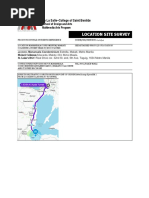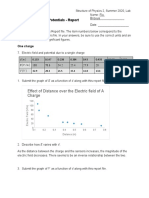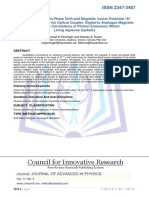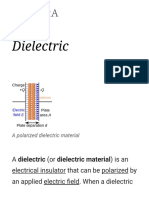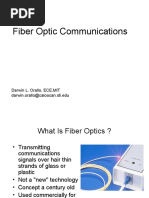Gauss Law Lecture Notes
Gauss Law Lecture Notes
Uploaded by
Chung Chee YuenCopyright:
Available Formats
Gauss Law Lecture Notes
Gauss Law Lecture Notes
Uploaded by
Chung Chee YuenOriginal Description:
Copyright
Available Formats
Share this document
Did you find this document useful?
Is this content inappropriate?
Copyright:
Available Formats
Gauss Law Lecture Notes
Gauss Law Lecture Notes
Uploaded by
Chung Chee YuenCopyright:
Available Formats
Causs' Law
knlghL: ChapLer 28: 1 - 6
COPYRIGHT REGULATIONS 1969
Schedule 4
(regulation 4D)
FORM OF NOTICE FOR PARAGRAPH 49 (7A) (c) OF THE
COPYRIGHT ACT 1968
COMMONWEALTH OF AUSTRALIA
Copyright Regulations 1969
WARNING
This material has been provided to you pursuant to section 49
of the Copyright Act 1968 (the Act) for the purposes of
research or study. The contents of the material may be subject
to copyright protection under the Act.
Further dealings by you with this material may be a copyright
infringement. To determine whether such a communication
would be an infringement, it is necessary to have regard to the
criteria set out in Part 3, Division 3 of the Act.
2
Cb[ecuves:
CalculaLe Lhe elecLrlc ux Lhrough a surface,
use Causs' Law Lo calculaLe Lhe elecLrlc eld
of symmeLrlc charge dlsLrlbuuons,
undersLand how Lo recognlse and use
symmeLry ln Causs' Law calculauons,
use Causs' Law Lo undersLand Lhe properues
of conducLors ln an elecLrlc eld.
Electric Flux and Gauss' Law:28.3
Gauss' law ! method for calculating E-field for even
quite complex charge distributions, provided they have
reasonable degree of symmetry. Gauss' law relies on
concept of electric flux.
Define Electric Flux "
through surface S:
is vector normal to surface with
magnitude equal to area of A
= # of field lines passing
through area A
!
!
A
!
!
E
!
"
!
"
!
!
A
!
"=
!
E .
!
A = EAcos#
Electric Flux and Gauss' Law:28.3
!
!
A
!
!
E
!
" = 0
!
"=
!
E .
!
A = EAcos#
!
"= EAcos# = EA
!
!
A
!
!
E
!
" = 90
!
!
"= EAcos# = 0
For an arbitrary surface:
For a closed surface which
does not enclose any
charges:
# of field lines in is equal to
# of field lines out
so net flux " = 0.
(surface normal points outwards everywhere)
!
"=
!
E .d
!
A
#
!
d
!
A
!
!
E
!
d
!
A
1
!
d
!
A
2
!
!
E
!
!
E
!ve flux
components
+ve flux
components
For a closed surface that
does not enclose any
charges:
Negative flux contributions
from field lines entering
surface must exactly
balance positive flux
contributions from field
lines exiting surface.
!
d
!
A
1
!
d
!
A
2
!
!
E
!
!
E
-ve "
+ve "
ConcepL 1esL:
A buuery neL ls ln a
unlform elecLrlc eld, !,
a s s h o w n l n L h e
accompanyl ng gure.
1he rlm, a clrcle of radlus
a , l s a l l g n e d
perpendlcular Lo Lhe
elecLrlc eld. llnd an
ex pr es s l on f or L he
elecLrlc ux, !, "#$%&'#
(&)" "#* +*,+'-
Gauss' Law: 28.4
Electric flux, " , through arbitrary closed mathematical
surface with charge q within is:
For charge q enclosed within
surface, # of field lines emerging thru
surface is q / #
0
Charges outside volume
contribute no net flux
(integral over closed surface)
(NB. use signed value for q so that
" can be +ve or -ve)
!
"=
!
E .d
!
A
#
=
q
$
0
!
q
+
+
!
q
Applying Gauss' Law: 28.5
E-field for -ve point charge:
-
Choose spherical surface (Gaussian
surface) of radius r with point charge at
centre:
(- sign since E and dA opposite in direction)
NB. Problems usually simplified by careful choice of Gaussian surface, i.e.
choose one for which field lines parallel or perpendicular to surface normal(s).
!
"=
!
E .d
!
A
#
= $E d
!
A =
#
$q
%
0
!
"q
!
" #E4$r
2
=
#q
%
0
" E =
1
4$%
0
q
r
2
!
d
!
A
!
!
E
ConcepL 1esL:
A polnL charge ls placed aL
one corner of a cube of slde
lengLh , as shown ln Lhe
accompanylng dlagram. use
Causs' law and symmeLry
argumenLs Lo nd Lhe "%"./
*/*0"$10 2&3 "#$%&'# "#*
0&4*. !
a
!
+q
!
a
!
+q
4 cubes behind and 4 in front will
completely surround charge q
E-field for line of charge:
linear charge density $ C/m
!
d
!
A
end 2
!
d
!
A
side
!
d
!
A
end1
+
+
+
+
+
+
+
+
!
!
E
E perpendicular to dA for ends of
Gaussian surface so they do not
contribution to flux.
Choose cylindrical Gaussian
surface to match symmetry of
charge distribution (radial field).
!
r
!
h
!
"=
!
E .d
!
A
#
=
q
$
0
!
" E2#rh =
$h
%
0
" E =
1
2#%
0
$
r
Side area of cylinder
Charge in cylinder
E-field for large flat insulating sheet of charge:
Choose cylinder with axis perpendicular to plane of charge:
Fig.28.27 Knight, Physics for Scientists and
Engineers, 2
nd
Ed.
!
"=
!
E .d
!
A
#
=
q
$
0
E perpendicular to
dA for side of
Gaussian surface
so only ends
contribution to flux.
!
" EA+ EA =
#A
$
0
" E =
#
2$
0
Areal charge density %
Gauss' Law and Symmetry: 28.1
Gauss' Law can be directly applied in situations that
have sufficient symmetry:
!
Cylindrical (e.g. Wire)
!
Spherical
!
Planar (e.g. Sheet of charge)
Fig.28.6 Knight, Physics for Scientists and Engineers, 2
nd
Ed.
Gauss' Law and Symmetry:
NB. It is desirable if possible to find a Gaussian
surface in which the surface normal is either
perpendicular to or parallel to the electric field vector
at each point on the surface:
!
!
E
!
" = 0
!
!
A
!
!
E
!
" = 90
!
!
!
A
Gauss' Law and Symmetry:
Gauss' Law gives the electric field at a Gaussian
surface arising from the charge, q , enclosed within
the surface.
To get the resultant E-field at some point P in space,
need to consider influence of all charge distributions,
both inside and outside the Gaussian surface
chosen, e.g. "
E =
20
sheet A
20
sheet B
= 0
For asymmetric distributions:
Gauss' Law + Superposition
can sometimes be applied.
+
+
+
+
+
Sheet A
+
+
+
+
+
Sheet B
P
Gauss A
Gauss B
+
+
+
+
+
Sheet A
+
+
+
+
+
Sheet B
P
Symmetric Case with Two Charged Sheets:
!
"=
!
E .d
!
A
#
=
q
$
0
% EA + EA =
&A+&A
$
0
% E =
&
$
0
E.g. solid sphere with uniform charge density & C/m
3
throughout volume (total charge Q)
sphere
Spherical Gaussian surface
!
r " R: q =
Q
4
3
#R
3
4
3
#r
3
= Q
r
3
R
3
!
"=
!
E .d
!
A
#
=
q
$
0
!
" E4#r
2
=
Q
$
0
r
3
R
3
" E =
Q
4#$
0
r
R
3
(linear with r )
R
r
E.g. solid sphere with uniform charge density & C/m
3
throughout volume (total charge Q)
sphere
Gaussian surface
!
r " R: q = Q
!
"=
!
E .d
!
A
#
=
q
$
0
!
" E4#r
2
=
Q
$
0
" E =
1
4#$
0
Q
r
2
(same as for field vs r for point charge Q)
i.e. inverse square dependence as for point
charge.
R
r
For concentric spherical cavity in sphere, E = 0
within empty interior volume. Why?
!
" r # R: E =
Q
4$%
0
r
R
3
=
1
4$%
0
q(r)
r
2
!
r " R: q = Q
r
3
R
3
#q r ( ) = Q
r
3
R
3
q as function of r
Same form as expression for r > R now.
E at r only depends on q inside radius r and if q is zero then so is E.
NB. Need to invoke symmetry arguments to show that the spherical shell
cannot contribute to an electric field anywhere inside the cavity.
Exercise: Applying Superposition:
E.g. +ve charge Q distributed uniformly over volume of solid sphere of radius R.
Then spherical cavity, radius R/2, cut from sphere and associated material/charge
discarded.
Use superposition arguments to show that
E-field at P is given by:
!
E =
Q
4"#
0
1
r
2
$
1
8 r $ R/2 ( )
2
%
&
'
'
(
)
*
* R
R/2
Superposition ! field at P given by:
R
R/2
Conductors in Electric Fields: 28.6
In conductor, large # of free electrons available ! when
conductor placed in E-field, free electrons move in
opposite direction to field leaving one surface +vely
charged and other -vely charged:
conductor
- -
-
-
-
!
!
E
ext
- - - - -
+ + + + +
Charge separation generates internal E-field E
int
opposite
in direction to the external field.
Separation of charge
continues until:
- - - - -
+ + + + + +
-
At equilibrium E
net
= 0
everywhere inside
conductor
!
!
E
int
!
!
E
ext
!
!
E
int
=
!
E
ext
!
!
E
net
= 0
Similarly, excess charge on conductor resides at the
surface:
+ +
+
+ + +
+
+ + +
+
+
(same equilibrium condition
applies)
This is also what we would expect based on charge
repulsion and minimisation of potential energy (see
later).
!
!
E
net
= 0
+
+
+
+
+
+
Also, at equilibrium, field lines at
surface of conductor are
perpendicular to the surface at
every point
(otherwise there would be net lateral force on
charges and they would move)
E-field Outside Large Flat Conducting Plate:
+
+
+ +
+ +
Charge density % C.m
-2
E = 0 inside conductor
! only non-zero flux is that
through external end of
cylinder:
E-field is double that of insulating sheet with same
charge density. (Same # of charges per unit area !
same # of field lines BUT all field lines directed
outwards for conductor) OR consider that field outside
conductor has contributions from charges on top and
bottom surfaces.
!
" EA+ 0 =
#A
$
0
" E =
#
$
0
!
"=
!
E .d
!
A
#
=
q
$
0
!
!
E
= 0
!
!
E
E-field Outside Large Flat Conducting Plate:
Or, if you want to apply Gauss law in a symmetrical
manner:
!
" EA+ EA =
2#A
$
0
" E =
#
$
0
!
"=
!
E .d
!
A
#
=
q
$
0
+ + + + + + + +
+ + + + + + + +
!
!
E
!
!
E
!
"
!
"
Charge on top and bottom surfaces
Hollow Conductor :
+
+
+
+
+
+
cavity
Since excess charge resides
on surface and E =0
everywhere inside conductor,
must also be true for cavity
anywhere inside conductor.
no net charge inside Gaussian surface
! metal shell or cage "shields" interior from electric field
! Faraday Cage
NB. The electrostatic potential will give us a better way of arguing that there
can be no electric field lines within an empty cavity in a conductor.
Faraday Cage:
Conductors shield their interior from E-field:
( Fig 25-19, Halliday, Resnick and Walker, Fundamentals Of Physics, Wiley
2001)
Conductors shield their interior from E-field:
Conductors shield their interior from E-field:
E=0 inside metal cage
Charge Transfer in van der Graaf generator
+
+
+
+
+
+ +
+
!
!
!
!
Introduce charge into cavity of
conducting shell.
+
Charge Transfer in van der Graaf generator
+
+
+ +
+
!
!
!
!
Connect inner conductor to shell.
Transfer charge to shell.
+ +
+
Charge Transfer in van der Graaf generator
+
+ +
+
To add more charge start the whole
process over again.
+
Charge Transfer in van der Graaf generator
Three Minute Quiz:
R
1
R
2
R
3
+Q
A solid conducting sphere of radius R
1
is
enclosed within a concentric spherical
conducting shell of inner radius R
2
and outer
radius R
3
, as shown. If charge +Q is
deposited on the central sphere:
(a) Sketch the equilibrium charge
distribution on the conductors and the
electric-field line distribution for all regions of
space.
(b) Use Gauss' law to find expressions for
the electric-field in each region and hence
plot a graph of E vs radial distance r.
Lightning:
When E-field exceeds 3 x 10
6
N/C (V/m) molecules in
air can become ionised (neutral molecules broken into
+vely and -vely charged ions):
+
-
these ions collide with neutral molecules ! more ions
created ! collision cascade ! spark.
!
!
E
E-Field of Earth:
Dry air E-Field of Earth ~ 100-200 V/m (N/C) pointing
downwards:
+
+
+
+
+
+
+
+
-
-
-
- - -
-
-
-
Earth = Giant Spherical Capacitor
Lightning = discharge through volume of capacitor
Sources of Mobile Charges:
Upper Atmosphere: Cosmic Rays (very swift particles
from space, mostly protons) enter atmosphere and
produce dense collision cascades of charged particles
(+ve and -ve).
Terrestrial: Ions produced by natural radioactive decay
and other ionisation processes including induced
charge on droplets of water spray:
E
+
+ +
+
-
+
-
-
Thunder Clouds
(From: http://littleswitzerlandweather.info/lightinfo/abtlightning.html)
Current understanding is that:
Small ice particles are being
charged positively and rapidly
transported upward.
~ +40 C
~ 40 C
Possible Charging Mechanisms
Ice particle polarised in E-field
+ charge exchange with water
droplet or another ice particle.
E
-
+
e-
Or -ve ions attracted towards
ice particle and captured.
E
-
+
-
ground strike
Lightning Strike:
( Figs 24-13, 24-14, Halliday, Resnick and Walker, Fundamentals Of Physics,
Wiley 2001)
Once column bridges gap, e- rapidly
transported:
" current
"e- collisions with air molecules
" ionisation
" further current
e- + air molecules
atom excitation
spontaneous decay
photons
flash
- - -
-
+ + + + +
Lightning:
Just prior to flash, electron avalanche descends to ground
Charge density in column $ ~ -1 x 10
-3
C.m
-1
and for line of charge
but visible region has radius ~ 0.5 m
!
" =1#10
$3
C/ m
!
E =
1
2"#
0
$
r
!
" r =
1
2#$
0
%
E
=
1
2#$
0
1&10
'3
3&10
6
= 6m
Discharge occurs first wherever E-field greatest:
+ + +
+
+
+
+ + +
so hit the deck if this happens
to you!
( Fig 25-24, Halliday, Resnick and Walker, Fundamentals Of Physics,
Wiley 2001)
Concept Test
A cylindrical piece of insulating material is placed in an external electric
field, as shown. The net electric flux passing through the surface
of the cylinder is
1. Positive
2. Negative
3. Zero
Summary:
LlecLrlc llux.
Causs' Law.
SymmeLry and superposluon.
ConducLor ln elecLrlc eld.
LlghLnlng and sLaylng allve.
8ead knlghL: ChapLer 28
You might also like
- Cambridge Ket Lesson PlanDocument11 pagesCambridge Ket Lesson Plankenny Ibraham100% (2)
- MagneticDocument14 pagesMagneticNurulazmi Bin Abd RahmanNo ratings yet
- Magnetic DipoleDocument4 pagesMagnetic DipoleLim Zheng LiangNo ratings yet
- Chapter 4 Magnetic Feild 2016 ReviewedDocument160 pagesChapter 4 Magnetic Feild 2016 ReviewedSyaza IzzatyNo ratings yet
- Electric Field in Material Space: Convection and Conduction CurrentsDocument25 pagesElectric Field in Material Space: Convection and Conduction CurrentsHassan Al BaityNo ratings yet
- Wave Generator WorksheetDocument7 pagesWave Generator WorksheetJhen Ivy50% (2)
- Mushrooming NGOs, INGOs and QuestionDocument5 pagesMushrooming NGOs, INGOs and QuestionRaj YadavNo ratings yet
- The History of Turbo CDocument9 pagesThe History of Turbo CMark Alvin Gonzales0% (2)
- John W. Creswell, Research DesDocument4 pagesJohn W. Creswell, Research Desmatamerah100% (2)
- Location Site Survey - RAMOSDocument12 pagesLocation Site Survey - RAMOSAaron Raphael RamosNo ratings yet
- Electric Flux and Gauss LawDocument31 pagesElectric Flux and Gauss LawVijay Jagwani0% (1)
- History of Electricity and MagnetismDocument3 pagesHistory of Electricity and MagnetismAngelNo ratings yet
- L1 Electricity and MagnetismDocument20 pagesL1 Electricity and Magnetismbussanmugwati2004No ratings yet
- Magnetic Properties of SolidsDocument3 pagesMagnetic Properties of SolidsSomiran DasNo ratings yet
- Broken Symmetry PDFDocument2 pagesBroken Symmetry PDFKimMmMmNo ratings yet
- Negative Resistance DevicesDocument4 pagesNegative Resistance DevicesHasitha Gayan JayasundaraNo ratings yet
- Chapter 2. Electric Field and Gauss's LawDocument9 pagesChapter 2. Electric Field and Gauss's LawAndes SaragiNo ratings yet
- 4 Electric FieldDocument25 pages4 Electric FieldDERRICKKEANNo ratings yet
- SuperconductivityDocument34 pagesSuperconductivityShubham ThakurNo ratings yet
- Superconductivity IntroductionDocument5 pagesSuperconductivity IntroductionNeelam KapoorNo ratings yet
- Electric Dipole MomentDocument13 pagesElectric Dipole Momentdaredevil26No ratings yet
- Earth's Young Magnetic FieldDocument3 pagesEarth's Young Magnetic Fieldeustoque2668No ratings yet
- The Photoelectric EffectDocument11 pagesThe Photoelectric EffectAlex Tarr100% (1)
- Magnetism & ElectromagnetismDocument38 pagesMagnetism & ElectromagnetismganapathiNo ratings yet
- James Clerk Maxwell and His EquationsDocument14 pagesJames Clerk Maxwell and His EquationsInsani IpNo ratings yet
- Band Gap: in Semiconductor PhysicsDocument5 pagesBand Gap: in Semiconductor PhysicstarquitaNo ratings yet
- Quantum Vacuum ThrusterDocument5 pagesQuantum Vacuum ThrusterLuis Alberto MiglioreroNo ratings yet
- 6 Modern Physics NotesDocument4 pages6 Modern Physics NotesHamza TahirNo ratings yet
- Electric FieldDocument37 pagesElectric FieldnesslycafsNo ratings yet
- Gravitomagnetic ANALOG OF Electric Transformer PDFDocument8 pagesGravitomagnetic ANALOG OF Electric Transformer PDFStanley Alexander Salvatierra BerriosNo ratings yet
- Electrostatics ReviewDocument28 pagesElectrostatics ReviewLumactod EarthanNo ratings yet
- Chapter 27 Magnetic Field and Magnetic ForcesDocument90 pagesChapter 27 Magnetic Field and Magnetic ForcesDilo TanNo ratings yet
- Quantum Field TheoryDocument16 pagesQuantum Field Theoryrr1819100% (1)
- Bohr-Van Leeuwen TheoremDocument4 pagesBohr-Van Leeuwen TheoremAdrij BanikNo ratings yet
- Chapter 12: Magnetic Vector Potential and The Biot-Savart LawDocument10 pagesChapter 12: Magnetic Vector Potential and The Biot-Savart LawKatherine RíosNo ratings yet
- Wiki - Double-Slit ExperimentDocument11 pagesWiki - Double-Slit ExperimentSeu SilvaNo ratings yet
- Lab 3 - Electric Field ReportDocument4 pagesLab 3 - Electric Field ReportfloNo ratings yet
- 2016 - The Aharanov-Bohm Phase Shift and Magnetic Vector Potential ADocument8 pages2016 - The Aharanov-Bohm Phase Shift and Magnetic Vector Potential AraduNo ratings yet
- ElectrostaticsDocument3 pagesElectrostaticsPeejay OllabracNo ratings yet
- Capacitance NotesDocument75 pagesCapacitance Notestuvvac100% (1)
- CH 29 Knight 4thDocument118 pagesCH 29 Knight 4thIshiCNo ratings yet
- DielectricDocument53 pagesDielectricPraveen KumarNo ratings yet
- Magnetic Field:: - Ampere's Circuital LawDocument4 pagesMagnetic Field:: - Ampere's Circuital LawKay RNo ratings yet
- Negative Impedance Converter - Wikipedia, The Free EncyclopediaDocument3 pagesNegative Impedance Converter - Wikipedia, The Free Encyclopediamaithuong85No ratings yet
- KroneckerDocument11 pagesKroneckersteven.sullivanNo ratings yet
- The Study Of, The and The Associated With Them.: Electric Charges at Rest Forces Between Them Electric FieldsDocument77 pagesThe Study Of, The and The Associated With Them.: Electric Charges at Rest Forces Between Them Electric FieldsJhen Ivy50% (2)
- The Tom Bearden Website: 174. Resonance: in Physics, An Oscillation PhenomenonDocument3 pagesThe Tom Bearden Website: 174. Resonance: in Physics, An Oscillation Phenomenonbill gavendaNo ratings yet
- Chaffee - Theory - of - Thermionic - Vacuum - Tubes PDFDocument688 pagesChaffee - Theory - of - Thermionic - Vacuum - Tubes PDFMichel CormierNo ratings yet
- Kepler's Law of Planetary MotionDocument30 pagesKepler's Law of Planetary MotionALJON EMPERADO100% (1)
- CHAPTER 21 - Special Theory of RelativityDocument4 pagesCHAPTER 21 - Special Theory of RelativityGerry Lou QuilesNo ratings yet
- Gauss LawDocument36 pagesGauss LawannyNo ratings yet
- Magnetic ReconnectionDocument62 pagesMagnetic Reconnectionjburleson11100% (2)
- Quantum ConfinementDocument19 pagesQuantum ConfinementBarnik GoswamiNo ratings yet
- What Is ElectricityDocument25 pagesWhat Is ElectricityJohn PetrovicNo ratings yet
- Foundation &fundamentals of Chemistry Unit: 3 Atomic StructureDocument34 pagesFoundation &fundamentals of Chemistry Unit: 3 Atomic StructurePiyush KumarNo ratings yet
- Unit 5 - Engg Physics NEP Superconductors and NanoDocument9 pagesUnit 5 - Engg Physics NEP Superconductors and NanojanhvilkwNo ratings yet
- Direct and Indirect Band GapsDocument4 pagesDirect and Indirect Band GapsSai Swetha KVNo ratings yet
- MODULE 4.5 Quantum PhysicsDocument9 pagesMODULE 4.5 Quantum PhysicsanjujobbyNo ratings yet
- Maxwell EquationsDocument36 pagesMaxwell EquationsAhmed TayehNo ratings yet
- SuperconductorsDocument31 pagesSuperconductorsnitibodhe100% (1)
- © 2016 Pearson Education, LTDDocument48 pages© 2016 Pearson Education, LTDArvind KumarNo ratings yet
- Direct and Indirect Band GapsDocument5 pagesDirect and Indirect Band GapsSenthil Siva SubramanianNo ratings yet
- P361 Lecture5a ConductorsDocument15 pagesP361 Lecture5a ConductorsPatrick SibandaNo ratings yet
- Gauss LawDocument28 pagesGauss LawchmscemNo ratings yet
- Electromagnetism NotesDocument25 pagesElectromagnetism NotesjamesmcmNo ratings yet
- CHK Industy 4.0 - Chapter 2 SlidesDocument14 pagesCHK Industy 4.0 - Chapter 2 SlidesChung Chee YuenNo ratings yet
- (Jooah) Presentation - UK Grey Kangaroo 2020 (29 Jan 2023) v2Document51 pages(Jooah) Presentation - UK Grey Kangaroo 2020 (29 Jan 2023) v2Chung Chee YuenNo ratings yet
- (Jooah) Presentation - Introduction To Indices (8 January 2023)Document75 pages(Jooah) Presentation - Introduction To Indices (8 January 2023)Chung Chee YuenNo ratings yet
- Chapter 11 - Data Analysis and Probability (Tuition)Document33 pagesChapter 11 - Data Analysis and Probability (Tuition)Chung Chee YuenNo ratings yet
- AQCMP 2015 - Superconductivity I - 1Document41 pagesAQCMP 2015 - Superconductivity I - 1Chung Chee YuenNo ratings yet
- Lecture21 LMS 2016 Sem1Document2 pagesLecture21 LMS 2016 Sem1Chung Chee YuenNo ratings yet
- Careerin 19-Week Investment Banking Workshop Behavioral Interview Guidance IDocument10 pagesCareerin 19-Week Investment Banking Workshop Behavioral Interview Guidance IChung Chee YuenNo ratings yet
- 9 投行技术面试【估值】 valDocument6 pages9 投行技术面试【估值】 valChung Chee YuenNo ratings yet
- SolutionsDocument15 pagesSolutionsChung Chee YuenNo ratings yet
- Careerin 19-Week Investment Banking Workshop Lbo and M&ADocument7 pagesCareerin 19-Week Investment Banking Workshop Lbo and M&AChung Chee YuenNo ratings yet
- Building World-Class Finance and Performance Management CapabilitiesDocument8 pagesBuilding World-Class Finance and Performance Management CapabilitiesChung Chee YuenNo ratings yet
- Discrete Mathematics Asssignment 3Document4 pagesDiscrete Mathematics Asssignment 3Chung Chee YuenNo ratings yet
- Problem Set ZeroBonds SOLDocument4 pagesProblem Set ZeroBonds SOLChung Chee YuenNo ratings yet
- MAST20004 14 Assign2 SolDocument3 pagesMAST20004 14 Assign2 SolChung Chee YuenNo ratings yet
- TimemanagementgridDocument4 pagesTimemanagementgridapi-310887783No ratings yet
- MAST20004 14 Assign4 PDFDocument2 pagesMAST20004 14 Assign4 PDFChung Chee YuenNo ratings yet
- Biology 10004 Lab 3 ReportDocument3 pagesBiology 10004 Lab 3 ReportChung Chee YuenNo ratings yet
- Graph Theory Problem Sheet 1 SolutionDocument2 pagesGraph Theory Problem Sheet 1 SolutionChung Chee YuenNo ratings yet
- MAST20009 Vector Calculus, Semester 2 2015 Assignment 4Document1 pageMAST20009 Vector Calculus, Semester 2 2015 Assignment 4Chung Chee YuenNo ratings yet
- A Mathematics Primer For Physics Graduate StudentsDocument78 pagesA Mathematics Primer For Physics Graduate StudentsChung Chee Yuen100% (2)
- DCP Testing RADocument11 pagesDCP Testing RAjohanNo ratings yet
- Gender Inequality in Pride and PrejudiceDocument16 pagesGender Inequality in Pride and PrejudiceLisa BorgohainNo ratings yet
- Instant Download Realism and Complexity in Social Science 1st Edition Malcolm Williams PDF All ChapterDocument69 pagesInstant Download Realism and Complexity in Social Science 1st Edition Malcolm Williams PDF All Chaptermiddlegunong58100% (2)
- Application of Graph Theory To Find Minimal Paths Between Two Places For The Transportation ProblemDocument9 pagesApplication of Graph Theory To Find Minimal Paths Between Two Places For The Transportation ProblemIJRASETPublicationsNo ratings yet
- PVS 7 Manual v3Document44 pagesPVS 7 Manual v3Chris WhiteheadNo ratings yet
- 109428-BS en 583-4-2002Document18 pages109428-BS en 583-4-2002Nensha KagasawaNo ratings yet
- Fiber Optic Communications: Darwin L. Orallo, ECE, MIT Darwin - Orallo@caloocan - Sti.eduDocument31 pagesFiber Optic Communications: Darwin L. Orallo, ECE, MIT Darwin - Orallo@caloocan - Sti.eduGracie GracieNo ratings yet
- TeSys GV3 Manual Starters and Protectors - GV3P40Document8 pagesTeSys GV3 Manual Starters and Protectors - GV3P40Call me BRAYNo ratings yet
- Easy PRO80 BDocument3 pagesEasy PRO80 BAngga PebriantNo ratings yet
- Ed Syllabus 1Document2 pagesEd Syllabus 1Vinoth KumarNo ratings yet
- Digital Governance: An Assessment of Performance and Best PracticesDocument19 pagesDigital Governance: An Assessment of Performance and Best PracticesMohamed MetwallyNo ratings yet
- Amber Limited Main PPT SHRMDocument10 pagesAmber Limited Main PPT SHRMimadNo ratings yet
- Character Profile - Ruby ThorneDocument2 pagesCharacter Profile - Ruby ThorneCameron TurnerNo ratings yet
- Universidad Nacional Autónoma de Nicaragua: UNAN-LeónDocument4 pagesUniversidad Nacional Autónoma de Nicaragua: UNAN-LeónjuanNo ratings yet
- Grade 1 MELC Compilation PDFDocument33 pagesGrade 1 MELC Compilation PDFXyrile Joy Siongco0% (1)
- DrainFlow_Case_StudyDocument12 pagesDrainFlow_Case_StudyaymansamadchowdhuryNo ratings yet
- 836 Rescue Winch: Maintenance Manual Bo 105Document95 pages836 Rescue Winch: Maintenance Manual Bo 105cleberNo ratings yet
- F-16XL Ship #2 - NASADocument5 pagesF-16XL Ship #2 - NASAmachinemanNo ratings yet
- Building StoneDocument7 pagesBuilding StoneBereket BlessingNo ratings yet
- An Application of The Theory of Laser To Nitrogen Laser Pumped Dye LaserDocument78 pagesAn Application of The Theory of Laser To Nitrogen Laser Pumped Dye LaserNandipati Hemanth ReddyNo ratings yet
- C3 - Understand How To Safeguard Children and Young PeopleDocument9 pagesC3 - Understand How To Safeguard Children and Young PeopleFaiyaz MostafaNo ratings yet
- 938 Js LICENSEDocument3 pages938 Js LICENSE88 88No ratings yet
- Rare Giroxa Incabloc Antimagnetic 17 Jewels Vintage Watch W Seconds Hand, Works EBayDocument1 pageRare Giroxa Incabloc Antimagnetic 17 Jewels Vintage Watch W Seconds Hand, Works EBayRadu CiurariuNo ratings yet
- Chapter 4 Understanding Data and Ways To Systematically Collect DataDocument5 pagesChapter 4 Understanding Data and Ways To Systematically Collect DataMARY JUDIELL VILLANUEVANo ratings yet
- Sports PsychologyDocument31 pagesSports PsychologyEric John Mangadlao Manila0% (1)









